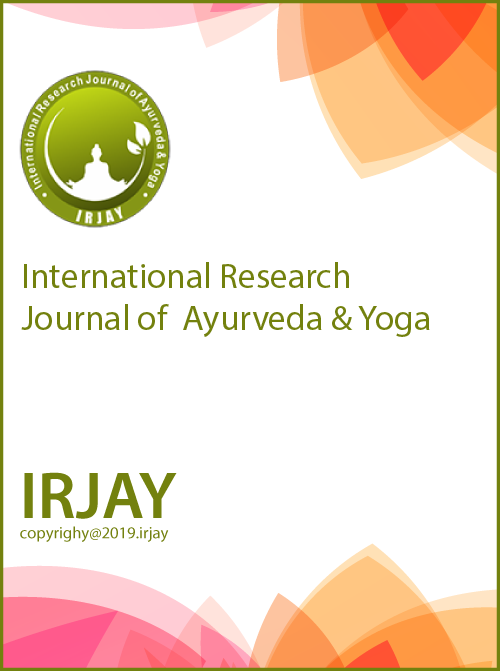Role of Ayurveda in the Management of Alcohol Addiction: A Case Report
Keywords:
Alcohol addiction, CIWA Score, Madatya, Shaman Chikitsa, ShirodharaAbstract
Introduction: When significant doses of ethyl alcohol beverages are consumed on a regular basis for an extended period of time and are accompanied by a morbid need to drink alcohol, it is considered alcohol addiction. Main Clinical Findings: A 45-year-old male who had been drinking for 5 years took a 3-day break. As a result, he began to experience anxiety, weakness, tremors, decreased appetite, and weariness as symptoms of alcohol addiction, along with disrupted mental status and sleep. Diagnosis: The CIWA-Ar scale was used to evaluate the patient’s status. Interventions: The patient was given internal medicine as well as Shirodhara for 1 month. Outcome: For 1 month, he received indoor patient care using a mix of internal pharmaceuticals and Ayurvedic treatments. The patient’s condition, mental illness, and signs and symptoms are all improved by this treatment. Conclusion: As a conclusion, it is imperative that the nation, society, families, addicts, and women who bear the brunt of this issue focus more on de-addiction in a method that yields the best results and has no negative side effects. The World Health Organization (WHO) has released data showing that for people over 15, the annual total amount of pure alcohol consumed per capita is 6.2 L, or 13.5 g, of pure alcohol.[1] In Ayurvedadipika, Acharya Chakrapani said that an Apathya (unwholesome) material is more or less innocuous if it becomes homologous with repeated use, even though it could be poisonous.[2] A person who has quit drinking alcohol experiences Dhvamsaka and Vikshaya if he suddenly resumes excessive alcohol use.[3] This word was also explained by Acharya Kashyap under the Panapkram category.[4] The three management steps that are available are intervention, detoxification, and rehabilitation. Trividh Parikshan, which combines Prashan (questioning), Darshan (visual observation), and Sparshan (tactile sensing), is a special
Downloads
References
1. World Health Organization. Obesity and overweight; 2016 Available from: http://www.who.int/substance-abuse/publications/ global-alcoholreport/msb-gsr-2014-1.pdf?ua=1 [Last accessed on 2018 Oct 12].
2. Samhita C. Chikitsa sthan, madatya chikitsa adhyaya, 24/201-202. Available from: https://www.niimh.nic.in/ebooks/ecaraka [Last accessed on 2024 Oct 15].
3. Samhita C. Chikitsa sthan, madatya chikitsa adhyaya, 24/107. Available from: https://www.niimh.nic.in/ebooks/ecaraka [Last accessed on 2024 Oct 15].
4. Samhita C. Chikitsa sthan, madatya chikitsa adhyaya, 24/232- 241. Available from: https://www.niimh.nic.in/ebooks/ecaraka [Last accessed on 2024 Oct 15].
5. Annamoreshwarkunte. Ashtangahrudaya samhita of vagbhata with the commentaries; sarvangasundara of arunadatta and ayurvedarasayan of hemadri, chaukhamba Sanskrit sansthan. Cha. 1., Ver. 22. Varanasi: Sutrasthan; 2012. p. 14. Available from: https://
vedotpatti.in/samhita/Vag/ehrudayam/?mod=read. [Last accessed on 2024 Sep 11].
6. Clinical institute withdrawal assessment of alcohol scale. Available from: https://umem.org/files/uploads/1104212257-ciwa-ar.pdf [Last accessed on 2024 Sep 10].
7. Alcohol dependence and harmful alcohol use. Available from: https://www.ncbi.nlm.nih.gov/books/nbk65500 [Last accessed on 2024 Sep 11].
8. Aslam A, Kwo PY. Epidemiology and disease burden of alcohol associated liver disease. J Clin Exp Hepatol. 2023;13(1):88-102. doi: 10.1016/j.jceh.2022.09.001
9. Bhattacharya SK, Bhattacharya A, Sairam K, Ghosal S. Anxiolytic antidepressant activity of Withania somnifera glycolwithanolides: An experimental study. Phytomedicine. 2000;7:463-9
10. Bhasma MS, Pishti MS. Available from: https://www.ayurtimes. com/muktashukti-bhasma-mukta-shukti-pishti [Last accessed on 2020 May 05].
11. Dhuri KD, Bodhe PV, Vaidya AB. Shirodhara: A psycho physiological profile in healthy volunteers. J Ayurveda Integr Med. 2013;4(1):40-4. doi: 10.4103/0975-9476.109550
12. Vati AS. Available from: https://www.ayurmedinfo.com/2020/03/11/ amar-sundari-vati [Last accessed on 2024 Sep 12].


